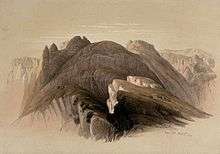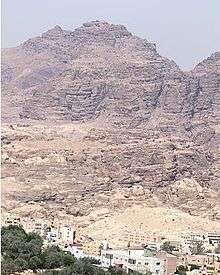Horites
The Horites (Hebrew: Horim, חרים), were a people mentioned in the Torah (Genesis 14:6, 36:20, Deuteronomy 2:12) inhabiting areas around Mount Seir in Canaan (Genesis 36:2,5).[1]
_p061_MT.HOR_TO_RIVER_ARNON_-_ARABIA_PETRAEA_IN_THE_SOUTH_COUNTRY.jpg)
Name
According to Archibald Sayce (1915), the Horites have been identified with references in Egyptian inscriptions to Khar (formerly translated as Harri), which concern a southern region of Canaan.[2] More recent scholarship has associated them with the Hurrians, with the biblical name "Hivite" being a reference to this same group.[3]
Hebrew Bible (Old Testament in the Christian Bible)
The first mention of the Horites in the Torah was when they were defeated by a coalition of Eastern kings led by Kedorlaomer of Elam (in modern Iran). These kings had come through the Horite territory to subdue a rebellion by a coalition of other 'kings' of peoples whom they had ruled for twelve years, who were living near the Dead Sea and Sodom and Gomorrah (Genesis 14:1-12).
Later, according to Genesis 36, the Horites co-existed and inter-married with the family of Esau, grandson of Abraham through Isaac (Genesis 25:21-25). They were eventually brought under the rule of the descendants of Esau, also then known as Edom.


The ancestry of Seir the Horite is not specified. Some say Seir lived around the time of Terah, father of Abraham. He is also said to be a descendant of Hor who is supposed to have lived around the time of Reu and was a descendant of Hivi, son of Canaan son of Ham. Pre-Edomite Horite chiefs, descendants of Seir, are listed in the Book of Genesis (Genesis 36:20-29) and 1 Chronicles (1 Chronicles 1:38-42). One of these chiefs, Zibeon, is also described as a Hivite. Esau's wife Oholibamah was his granddaughter (Oholibamah bat Anah bat Zibeon ben Seir; see Genesis 36:2,24,25). Their three sons all became 'chiefs,' although unlike other sons of Esau, they are not called chiefs "in Edom" (compare Genesis 36:16-18). This may indicate a transition time in which only certain Horite areas were becoming known as Edom.
The chiefs who descended from Esau are listed in Genesis 36:40-43. Two of these chiefs would appear to have been female - Timna and Oholibamah.
At some time, certain of these leaders rose to the level of 'kings' over the other chiefs, and the Horite land became known as Edom rather than the land of Seir. One example of these kings is Jobab, son of Zerah, a son of Esau and his wife Basemath, who was Ishmael's daughter (Genesis 36:35). Another is a 'Temanite', Husham (Genesis 36:34), a descendant of Esau's son, Teman (Genesis 36:10,11).
None of these kings' sons became kings after their fathers died. Apparently, there was no familial royal line whereby sons of these post-Horite kings succeeded to the throne, but rather, some other system was in place by which kings were either chosen or won the right to rule (Genesis 36:31-29).
By the time governance of these peoples had been consolidated under kings instead of chiefs, Horites are no longer mentioned as such. The land of Seir had become known as Edom.
References
- Horites at International Standard Bible Encyclopedia.
- James Orr, "Horites", in The International Standard Bible Encyclopedia, (1915) page 1421.
- Lawrence A. Sinclair (2000). "Horites". In David Noel Freedman (ed.). Eerdmans Dictionary of the Bible. W.B. Eerdmans. p. 607. ISBN 978-0-8028-2400-4.